#rorc – London's unique position at the crossroads of world sailing communications makes it a focus of attention in the winter months. Organisations of international standing will be having key administrative and decision-making meetings in the short non-sailing winter days, decisions which will impact on the coming season and the years beyond.
Sailing's world body, the International Sailing Federation, may take itself off in November to some choice destination resort for a week-long conference, with all expenses paid for the selected delegates. But the more specialist organisations rely to varying extents on voluntary workers with limited time and resources. Thus their constitutionally-required yearly gatherings tend to be compressed into just one day for an Annual General Meeting (AGM), with effective sub committees and executive officers being relied on to see that decisions made on that day are implemented through the coming year.
It has been a typical winter season in London with the AGM of the Royal Ocean Racing Club in December, and then January saw the annual log adjudication announcements of the Royal Cruising Club - it's a cruising achievement assessment process which goes back to 1896, while the club itself is far and away the world's most senior cruising organisation, as it dates back to 1880. The RCC meeting was then followed nine days later by the Annual General Meeting of the Old Gaffers Association, founded 1963 and now maturing very well as an international body.
There was nothing at all unusual in the fact of these three meetings being held. But it was unusual that, in all three gatherings, the leading roles were filled by Irish sailors. W M NIXON takes up the story.
When Michael Boyd became Commodore of the Royal Ocean Racing Club on December 1st 2014, it was at the conclusion of a year in which Ireland had performed exceptionally well in the club's international racing programme, with a clear victory in the Brewin Dolphin Commodore's Cup series, while Anthony O'Leary's Ker 39 Antix from Cork became RORC "Yacht of the Year" after a season which included winning the club's National IRC Championship and being Captain's Boat in the Commodore's Cup squad.
But it was steady years of service on committees and in the secondary flag officer roles, rather than Irish success in the club's racing, which led to Michael Boyd's elevation to the top post, allied to his long personal involvement of participation in all the main RORC events, and many minor ones too.
And it was not the first time an Irish sailor has played a key role in this unique organisation. Back in August 1925 at its founding in Plymouth immediately after the first Fastnet Race, one of the seven skippers involved was Harry Donegan of Cork, whose 50ft cutter Gull had placed third overall in what was to prove a turning point in world sailing history.
Although the newly formed Ocean Racing Club was to more or less kidnap the Fastnet Rock to become one of its symbols, Donegan was the only skipper who had raced round it before. He had taken part in the time-honoured contests from Cork Harbour to West Cork, supporting Schull Regatta which dates back to 1884, while Baltimore regatta can probably claim similar longevity. And Harry Donegan knew West Cork well, having been producing privately distributed sailing directions for cruising enthusiasts to its harbours and anchorages since at least 1912.
But inevitably, with the RORC's initial concentration of keen and resource-rich boat-owners sailing from southeast England and focused on London, it was some time before there was another significant Irish presence in the administration of what was gradually developing as world offshore racing's central organization. However, by the 1960s, Denis Doyle of Cork was becoming much involved as a dedicated participant in the RORC offshore programme and on its committee, and by the 1970s he was a Flag Officer.
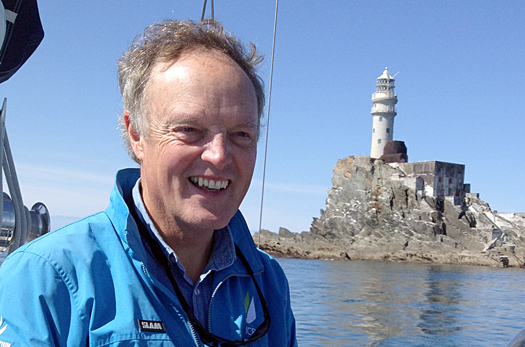
Newly-elected RORC Commodore Michael Boyd at the Fastnet Rock
Yet it was not until 1994 that Ireland provided our first RORC Commodore, John Bourke of Dun Laoghaire. In addition to being a successful offshore skipper in his own right, he had frequently been Denis Doyle's navigator in Moonduster successes, he'd also been a navigator-tactician in Ireland's fourth-placed Admirals Cup tea in 1987's thirteen-team series (our best-ever AC placing, with the Dubois 40 Irish Independent helmed by Tim Goodbody winning the Fastnet overall), and he'd served as President of the Irish Yachting Association.
But John Bourke took over the lead role in the RORC when the times were changing rapidly. Rising costs and the increase in pure professional sailing meant that major international semi-Corinthian events like the Admirals Cup were in rapid decline. And the negative effects of the Fastnet Race disaster of 1979, when 15 lives had been lost, were still being felt in turnouts for RORC events, as much more stringent regulations had led to cost increases and more demanding qualifications for participation. Then too, changing perceptions of the requirements of family life meant that the relatively selfish pattern of offshore racing participants disappearing for frequent long weekends of racing were simply no longer acceptable.
Against that, the RORC had played a key role in co-ordinating and administering the new global International Offshore Rule for handicapping. Then when rapidly evolving boat design and building techniques meant that the IOR was no longer fit for purpose, the RORC was ideally placed to oversee the changeover to the International Rating Certificate (IRC) through experience gained with the administration of the Channel Handicap system, of which elements were kept secret in order to avoid computer-aided exploitation.
So by staying with what it did best, the RORC began to prosper again. As time passed, the sheer horror of the 1979 Fastnet was slowly healed in the memory, so much so that the simple reality is that nowadays, the mythology of '79 adds to the allure of the event. In other words, the entry limit of 340 boats for the Rolex Fastnet Race 2015 was virtually filled within hours of opening. The club really does have a problem of success.
Meanwhile, it has added to the complexity of its shoreside structures by merging with the Royal Corinthian Yacht Club in Cowes. So the RORC is now a club with two clubhouses. There's the historic townhouse HQ in St James's Place in the heart of fashionable London into which it was guided in its early days by ocean racing legend John Illingworth. And there's now a summer place right beside the Royal Yacht Squadron, a rambling building with a colourful history, as members of the Royal Corinthian YC had bought it in the first place from the noted London "hostess" Rosa Lewis, who transferred her boisterous hospitality operations to Cowes during the height of the summer season.
With the new setup possibly being perceived by some members and potential members from other areas and distant nations as too much of a London-Solent nexus, it's interesting to hear that the RORC membership is continuing to increase in a very encouraging way. Clearly, these are exciting times for an organisation of increased global standing, so it's fascinating to note that the two key players in today's RORC administration are keen sailors who took their first serious steps afloat at the same time at two ports just 54 miles apart on each side of the Irish Sea.
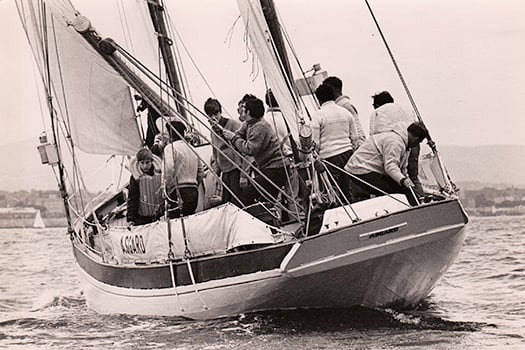
Michael Boyd has his first offshore sailing experience aboard the first Asgard in 1969.
Michael Boyd (64) may work in a demanding London-based international consultancy, and his Irish home may be in the depths of the country in the hidden northern reaches of County Meath, but in sailing terms he's Dun Laoghaire through and through. His father Liam was a stalwart of the Dublin Bay 21 class, and his own first forays offshore were as a youthful trainee aboard the 51ft ketch Asgard under Captain Eric Healy's command during the early days of the historic vessel's six seasons as Ireland's sail training vessel from 1969 to 1974.
At precisely the same time, just across channel in North Wales, his contemporary the young Eddie Warden-Owen was cutting a swathe through dinghy sailing at Treardur Bay and Holyhead. Very quickly, with a GP14 called Gwladys, he was achieving national success, and that in turn led to a career in sail-making and then on to professional sailing at the very top level – his success as coach in making a formerly lacklustre Italian campaign into serious contenders in the America's Cup is now text-book material in advanced sailing courses.

Michael Boyd's choice of a J/35 as his first serious offshore racer was a shrewd decision. He won the Round Ireland Race with the J/35 Big Ears in 1996, and more recently the J/35 has been one of the few exceptional boats to be inducted into American Sailing's Hall of Fame
As for Michael Boyd's sailing career, while it had to be fitted in with hyper-demanding international business commitments, he first really hit the headlines in 1996 with the overall win of the Round Ireland Race with his J/35 Big Ears. He was a regular and successful contender in RORC events, but these days his personal and family boat is through a partnership in the handsome Sparkman & Stephens-designed Maine-built performance cruising ketch Southerly, which is based at New Ross in County Wexford on the tidal section of the River Barrow, while his racing needs were met during 2014 by chartering the Grand Soleil 43 Quokka with fellow RIYC member Niall Dowling.
With Quokka, they were not only a much-valued part of the winning Irish Commodore's Cup team, but were top boat in Cork Week 2014 to win both the Hugh Coveney Cup and the historic 1859-vintage "Kinsale Kettle", a splendidly ornate and substantially-sized bit of Victorian silverware "which we were allowed to sit beside for just about ten minutes – there was no question of taking it home to Lobinstown".
The co-skipper of Quokka (they've chartered her again for 2015) is clearly an enthusiast who relishes our sport, and the ins and outs of sailing in all its ramifications. He makes an ideal person to be Commodore of the RORC at an important juncture in its development, and with Eddie Warden-Owen as the club's CEO, he has a kindred spirit with whom ideas can be developed and implemented at impressive speed.

Eddie Warden-Owen, CEO of the rapidly-developing Royal Ocean Racing Club. He was starting to hone his renowned racing skills at Holyhead just 54 miles across channel from Dun Laoghaire where, at exactly the same time, Michael Boyd was starting his sailing career.
So when your reporter had lunch with the new Commodore just eight days ago, he should have kept the main man strictly on track for a serious discussion of the challenges that club and sport face. And so we did for a while. But when you're with somebody with Michael Boyd's personal enthusiasm for participation sailing, dusty discussions on administrative matters have to run in parallel with wide-ranging and entertaining talk of sailing, boats, sailing folk and the wonders of the sea – the man certainly knows his boats and places and people .
Underneath it all, there was a good impression of the necessary range of his activities – for instance, in the week he became Commodore, he had to be in France for the RORC's Paris Dinner linked to the annual Boat Show there, and he is keenly aware of the club's global spread and the significance of people like Piet Vroon of the Netherlands and the Gouy family of France with their truly international approach to the sport and their regular participation in the Round Ireland Race.
Looking to the west, the club has a strong presence in the Americas, which has been reinforced with the annual RORC Caribbean 600 every February since 2009. This year it will see an uplift in the entries by hundred footers, notably by Syd Fischer's "new hull/original deck and rig" Ragamuffin 100 fresh from the Rolex Sydney Hobart Race, another event in which IRC is the key handicap system.
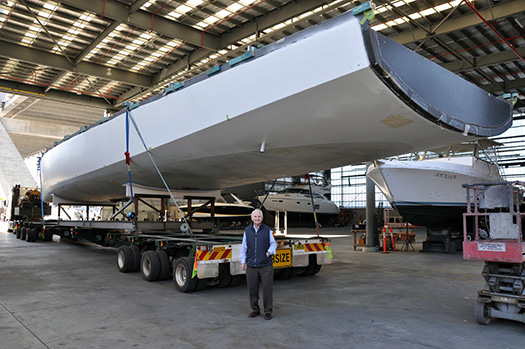
Definitely a sport for life. Syd Fischer, 87-year-old legend of Australian sailing, with the new hull for his hundred footer Ragamuffin just a few months before the recent Rolex Sydney-Hobart Race. Ragamuffin made it in time for the race, she took third on line honours, and now she is being shipped to Antigua to race the RORC Caribbean 600 in February.
But although in Australia the IRC is administered by Hobart race organisers the Cruising Yacht Club of Australia, for the biennial Rolex Fastnet in August and annual Rolex Middle Sea Race from Malta in October, the RORC's Rating Office, based in Lymington under the direction of Mike Urwin, is directly in charge. The Rating Office celebrated 30 years of the IRC Rule in 2014 with a growth in ratings issued after a slight decline during the years of economic recession, and the Lymington unit's unrivalled breadth of experience in the ways of bots and designers and offshore racing give it a special worldwide standing, yet another factor in the RORC's unique position in global sailing.
With their combined experience and proven administrative and international skills, the Boyd/Warden-Owen team are able to provide such formidable leadership for an organization which is central to our sport that they are able to do so in an under-stated way which is ideal for dealing with the highly-individualistic characters who are the leaders in their sport.
So when the London sailing-decision-season started in December with the new setup brought into being in the RORC, clearly things were moving in the right direction. Whether they continued to do so with the next item on the agenda, the Royal Cruising Club awards on January 8th, only time will tell. For this time round, I was the one in the hot seat adjudicating, and you feel the hand of history firmly on your shoulder when you're allocating a trophies which have been won in times past by the likes of Conor O'Brien.
But we'll return to that particular restrospective at the conclusion of this article – meanwhile, how did things go at the Old Gaffers Association AGM last Saturday? Sean Walsh of the Dublin Bay Old Gaffers Association became the first overall president from outside the southeast of England a year ago, so this was the first AGM under his guidance throughout, and it's not a task for the faint-hearted.

Sean Walsh, President of the OGA, sailing in company with the 100ft Viking ship Sea Stalllion.
As the Old Gaffers Association, with its 5,000-plus members in nine countries, is run almost entirely on a voluntary basis, their AGM is virtually a day long affair, a conference really, which started with an intense General Management Committee meeting (the GMC is made up of the Presidents and Hon Secs of each of the many branches) which is a two hour affair which started at 11am and concluded with a brief lunch break before the fully-fledged AGM took up the entire afternoon and went on well into the evening, a four hours-plus session which was to satisfactorily cover an exceptional range of topics.
The OGA may have had fairly casual get-togethers and an annual race or two as its main activities when it was founded in 1963. But now it has evolved into an active group with an impressively developing website and a widespread season-long programme which still has to take account of the notable individuality of the membership and the astonishing variety of their boats.
They even have a very active trailer section in which characterful yet trailerable gaff-rigged boats can suddenly appear in significant numbers at remote sailing locations – the highest lake in Wales, for instance – and they're developing the concept of "Raids" in attractive cruising areas. In these, the fleet keeps together by a relaxed form of racing in which the boat which has got into the lead is only allowed to stay there for five minutes, then she's obliged to go to the back of the fleet. If using the idea for larger slower-manoeuvring boats, you'd probably make the time at the front of the fleet a bit longer, but nevertheless it's a concept of great potential.
As for activities on the sea, while the main focus of 2014 was the Cruise-in-Company in the Netherlands to celebrate the tenth anniversary of the Dutch branch, in 2015 the focus will be on two cruises-in-company, one to St Malo in northeast Brittany to accommodate the large fleet numbers on the south coast of England and on both sides of the southern North Sea, and the other – aimed at the fleets in southwest England and on both sides of the Irish Sea – assembling at Kinsale on July 17th.
This fleet will go on westward for a week centred around the Glandore Classics, though with forays to the Fastnet Rock and other nearby ports. Glandore will then be followed by a further two weeks cruising towards West Kerry with a circuit of Skellig Michael the target, followed by more leisurely cruising homewards. In all, an epic three week venture which, like the OGA's successful Golden Jubilee Round Britain Cruise-in-Company in 2013, will probably see some boats joining and leaving at different intervals, though for most, staying the complete and very scenic course will be the target.
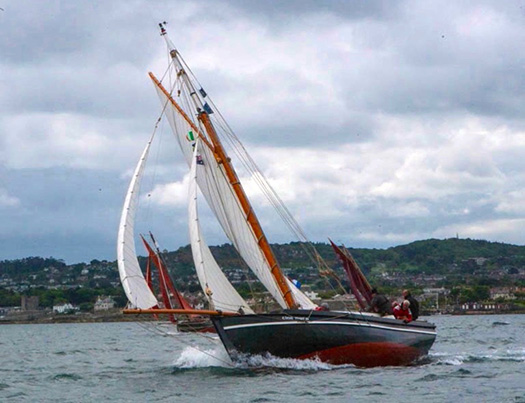
Cine Mara from The Netherlands. Rik Janssen's steel-built version of a traditional Galway Hooker, seen in Dublin Bay during the OGA Golden Jubilee Cruise-in-Company in 2013, was one of the flagships for 2014's Tenth Anniversary Cruise-in-Company for the Dutch Branch of the OGA. She is expected back in Ireland for the 2015 Glandore Classics in July, and the subsequent Old Gaffers Cruise-in-Company to West Cork and Kerry. Photo: Barry O'Loughlin
What with their intense GMC meeting in the morning, closely followed by his four hours and more of moderating the AGM in the afternoon over an exceptional range of topics, Sean Walsh and his team had a busy day of it. But as with any successful body, by the conclusion of the meeting the administrative officers were themselves re-enthused by the energy and commitment of their members. And from the Irish point of view, it certainly means that from July 18th to 24th we're going to have a CH Marine Glandore Classics Regatta 2015 on an unprecedented scale.
By contrast, the Royal Cruising Club works on the notion that small is beautiful. It has only 400 full members, but with a big history going back to 1880 when it was founded in London by a Trinity College Dublin graduate called Arthur Underhill, and its Challenge Cup goes back to 1896, which makes it far and away the world's senior cruising trophy.
In the early days, there were those cruising people who sniffed at the very idea of a "cruising competition". But contests such as this encourage the keeping of proper logs, which is an integral part of seamanship. And in an activity which is remarkably difficult to quantify, qualify and annotate, the story of the many winners gives us an unrivalled narrative of the development of cruising and cruising boats over the past 118 years.
Certainly it's something which the RCC - after some initial and understandable reluctance back in the early days – now takes very seriously indeed, so much so that the identity of the judge is kept an almost complete secret until the announcements go public in early January, and only a couple of others in the communications side of the club know the outcome of his or her adjudications after they've been made in early December – even the Commodore is kept in the dark until the January revelation.
The use of "his or her" in relation to the judge reflects the nature of this extraordinary club, which seems to have always had women members paying an active role. So much so, in fact, that it wasn't until after I'd made the list public that it was pointed out to me that of the awardees, more than half were women sailors. I simply hadn't noticed – I was only trying to highlight the twelve best cruises out of an impressive total of 40 logs submitted.
Most of the awards are of a relatively private or specialist nature within the club, but the Challenge Cup is of public interest – in the early days of the BBC radio, its recipient would be revealed on the airwaves. And another main award, the Cruising Club of America Bowl – went to a boat of Irish interest, the 44ft steel-built gaff yawl Young Larry (Andrew & Maire Wilkes) which is well-known about Dungarvan, as Maire was noted West Waterford solo sailor Maire Breathnach before she teamed up with Andrew.

The extensively-cruised steel gaff yawl Young Larry snugly moored in the pool just below the bridge in Dungarvan. Photo: Donal Walsh
This remarkable couple have also been recognised by the Irish Cruising Club, and in the spring they'll be presented with the ICC's Fastnet Trophy which is for exceptional achievements which have included a voyage circumnavigating North America, which of course included the east-west transit of the Northwest Passage. Having done and dusted the Northwest Passage, so to speak, in 2014 they returned to its southeastern approaches to cruise in detail the areas they'd to by-pass before, thus well-qualifying Young Larry for the CCA Bowl.
It's for a "cruise of any duration which includes a valuable contribution to Port and Pilotage information", and as Andrew and Maire's account of their cruise – which was via Ireland, Scotland, the Faeroes, Iceland, Greenland, Baffin island and Labrador before laying up for the winter in Newfoundland – is replete with sailing directions and anchorage information (sometimes obtained while in almost-too-close contact with polar bears), they fitted the Americans' requirements perfectly.
The Challenge Cup for the best cruise of the year has always had strong Irish associations, as in 1896 its first awardee (you don't "win" cruising trophies) was Dr Howard Sinclair of Belfast for a cruise round Ireland in his 23ft cutter Brenda. The pace and scale soon quickened, for in 1923, '24 and '25 it was awarded three years on the trot to Conor O'Brien of Foynes for his unprecedented global circumnavigation south of the great Capes in the Baltimore-built 40ft ketch Saoirse.
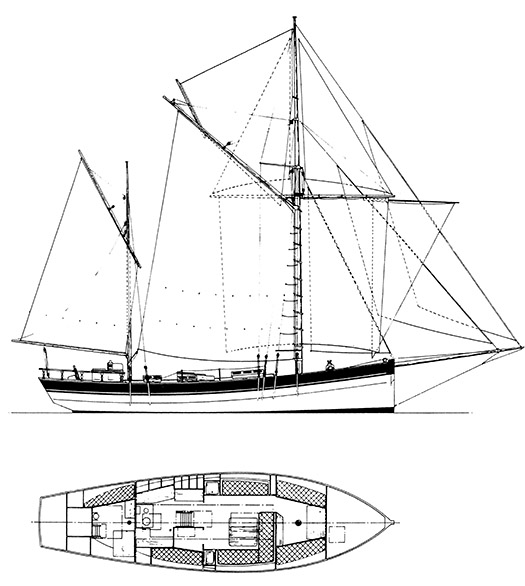
The Baltimore-built Saoirse. Conor O'Brien of Foynes was awarded the RCC Challenge Cup in 1923, 1924, and 1925 during his unprecedented global circumnavigation south of the great Capes in this 40ft ketch
More recently, Peter Guinness – originally of Howth – was awarded it in 1960 for an extensive cruise with the cutter Rob Roy McGregor, and then John Gore-Grimes from the same home port took it in 1985 for an exceptional Arctic cruise in the Nich 31 Shardana, the same skipper being honoured again for a long voyage north of Russia with the Najad 441 Arctic Fern in 2003.
Those who think the icy northern wastes are best left to polar bears will be cheered to learn that for 2014, I awarded the Challenge Cup to a sweet little own-built 34ft junk-rigged schooner which skipped across the oceans in the warmer zones like a flying fish. Then when she reached the end of each ocean voyage, her husband-and-wife crew would cruise each coastline visited as though that was the only cruise they'd be doing all year – in other words, with total enthusiasm and genuine interest in the people they met in some very obscure places.
But then, when you've a Jay Benford-designed Badger class schooner which you built yourself, you can comfortably fit in anywhere without offending the sensibilities of the locals by a gross display of affluence. Charlotte Waters – who is an artist – and her master craftsman/furniture designer husband Dan Johnson built their little boat Hestur with very limited resources near their cottage at Ullapool in Wester Ross in northwest Scotland. In their first season of 2013, they cruised to the Canaries via northwest Spain, then through 2014 they cruised on to West Africa and journeyed far up the Gambia River just before the outbreak of ebola, then went safely on their way to Cape Verde, across the Atlantic to cruise the Caribbean in detail, then on to Bermuda, the Azores, southwest Ireland, North Wales and so home to Ullapool leaving a very minimal carbon footprint in a voyage very worthy of the world's most senior cruising award.

Small and simple is beautiful and just right in a good cruising boat. Seen here far up the Gambia River in West Africa, this is the own-built Badger class schooner Hestur, whose owners Charlotte Watters and Dan Johnson of Ullapool in Scotland cruised extensively around and across the Atlantic. They have been awarded the RCC Challenge Cup for 2014. Photo: Charlotte Watters
































































